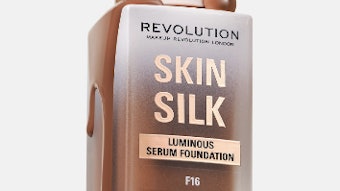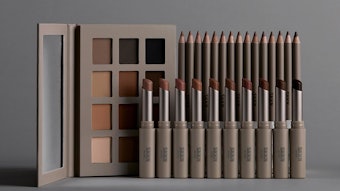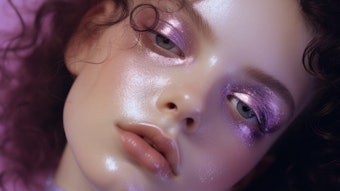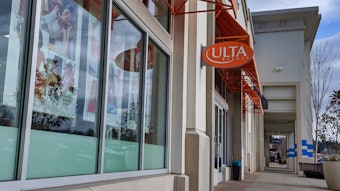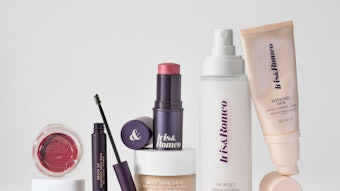Global color cosmetics sales reached $36.8 billion in 2007, according to Euromonitor International’s provisional 2008 data, representing an approximate 5% rise on the 2006 figure (in USD fixed exchange rate, current terms). While a seemingly healthy increase, cosmetics and toiletries are typically strong performers within the FMCG (fast-moving consumer goods) market, and, compared to other beauty categories, color cosmetics lag behind the average. In fact, Euromonitor International’s provisional figures suggest only the commoditized bath and shower category and depilatories, which faces stiff salon competition in many markets, recorded lower growth in 2007.
Category Leaders
Eye makeup, worth $10.1 billion, was the engine of dynamism in the global color cosmetics market during 2002–2006, and enjoyed a further year of category-leading growth of 6% in 2007, according to provisional Euromonitor International data. Dramatic, smoky eyes combined with nude lips, the “mod” look, dominated makeup trends across Western markets and continues to propel the sector. In addition, mascara is an important focus for innovation within the wider category. Meanwhile, facial makeup, which at $13.2 billion is the largest color cosmetics sector, showed the weakest performance in 2007. Not even a growing demand for blusher and bronzers was enough to offset the slowdown in the maturing foundation market.
Within the $10.1 billion lip products sector, lip gloss has been the champion of growth, with year-on-year increases of 9% between 2002–2006—approximately twice the level achieved by lipstick. Followers of the mod trend often opt for a sheer, glossy finish over the heavy matte coverage of a lipstick. In 2007, however, the market saw a resurgence in lipstick sales, and emerging markets are behind this growth.
Far from saturated and with large populations and dynamic economies, Eastern Europe and Latin America are propelling sales across the lip products sector. Since the mod look holds less sway in these regions, lipstick has become an important beneficiary of this growth. To a lesser extent, the Western markets are also contributing to a lipstick revival. In its latest incarnation, the mod trend calls for brighter, bolder lip colors, and some makeup firms are poised to tap into this new demand—PPR’s YSL Beauté, for example, launched Lip Twins, a lipstick/gloss duo, in early 2007.
At $3.5 billion, nail products is the smallest color cosmetics sector, and except for the booming demand for strengthening treatments, it holds the least promise for cosmetics firms.
Growth Slows in the Developed Markets
Emerging markets are injecting vibrancy into the global color cosmetics category. In terms of annual spending per woman, Eastern Europe and Latin America have seen growth of 78% and 55%, respectively, according to new provisional figures, albeit from a base well below the key value markets of North America and Western Europe. The Asia-Pacific markets of China and India are also becoming important sources of growth. China’s color cosmetics market will expand by almost $600 million through 2012, and India’s sales growth is predicted to be 19% annually over the same period. The global average for 2007–2012 is forecast to be closer to 2% per year.
The picture is less positive in the more developed markets. Euromonitor International’s provisional data shows sales of color cosmetics have declined every year for the last three in the U.S., and of Europe’s largest markets, only Spain and the U.K. achieved year-on-year growth during 2002–2007. Yet color cosmetics is one of the beauty market’s most innovative categories, and new product development is helping to lift unit prices and encourage limited volume growth in many developed markets.
Natural Ingredients vs. High-performance Technology
Natural ingredients, so central in driving up value in categories such as skin care and bath/shower products, have found their way into color cosmetics, and are offering women a range of added benefits aside from chemical-free formulations. Mineral makeup, for example, delivers important nutrients to the skin, provides a natural sunscreen, affords long-lasting coverage and is suitable for sensitive skin types. Bare Escentuals, a pioneer in mineral makeup, saw sales reach almost $400 million in 2006, although its market niche is increasingly being penetrated by the big name brands. Maybelline, L’Oréal Paris, Revlon and Almay are just some of the mainstream labels that have launched mineral makeup lines, and private label presence is also growing.
At the other end of the spectrum, some manufacturers are taking the high-tech approach in an attempt to satisfy demand for professional results that can be achieved at home. A new generation of makeup has emerged—tapping industries as diverse as Japanese printing, lighting and satellites in the pursuit of trendsetting products. Examples include Chanel’s limited edition Duo Platinum Holographic nail polish, which took inspiration from NASA’s satellite technology, and Givenchy’s Rouge Interdit, which incorporates the same liquid-crystal technology used to create a 3-D effect in plasma TVs. Dior’s Backstage collection is one of the most innovative ranges, featuring high concentrations of pigment, interesting textures and know-how borrowed from the toy manufacturing, food processing and car paint industries to allow home-based products to emulate the effects achieved
by makeup artists.
Finding New Target Markets
Reaching out to new consumer groups is a priority for many cosmetics companies, and the color cosmetics category is becoming increasingly segmented. One of the most recent areas for innovation is within the ethnic niche. In the U.S., the largest market for color cosmetics, Hispanics, African-Americans and Asians account for approximately one-third of the population, and their numbers are growing at more than twice the rate of the population as a whole. It is, therefore, no surprise that they are becoming a target for new color cosmetics launches. In 2006, Procter & Gamble’s CoverGirl launched its Queen Collection in the U.S. in partnership with singer/actress Queen Latifah. Prescriptives now offers Colorprint to suit ethnic skin tones, and MAC has used Missy Elliot, Mary J Blige and Lil’ Kim as spokesmodels.
Men have become a more unlikely target. In January 2007, three years after Jean-Paul Gaultier made the first steps into men’s makeup, Swedish clothing chain H&M launched a mascara for men. There is also an array of niche brands, notably KenMen. While it is unlikely that the men’s segment will find widespread appeal, segmentation by age holds more promise. Bratz mascara and the marykateandashley makeup line are just two examples of brands trying to capture some of the estimated $250 million teen consumers spend globally on consumer products each year. With an approximate buying power of $2.1 trillion in the U.S. alone, baby boomers are an even more tempting draw for cosmetics brands. However, the dramatic failure of Revlon’s Vital Radiance, aimed at women over 50, suggests that this consumer segment can be a difficult market to tap into.
Delivering on Innovation
Faster or improved application is a growing priority for women, and is the main thrust behind the extensive innovation in mascara brushes in recent years. More recently, it has filtered into the nail products sector with the launch of improved brushes to make applying nail polish faster and more accurate. Maybelline’s newest line extension, Express Finish 60 Second Nail Color, uses an exclusive control-flow brush—which is said to dispense the optimal amount of color for smooth, even application that resists chipping and peeling. The recent global launch of Bourjois 1 Seconde boasts a patented fan-effect brush that adapts to the size of each nail to provide one stroke application.
Sampling and single-use packs are also a growing trend in color cosmetics, providing convenience, portability and a low-cost way to experiment with new color combinations. Canadian makeup firm Cargo leads the way in this trend, offering products such as single-use eye shadow ColorCards and DailyGloss lip colors packaged in individual tear-away pouches.
Niche Brands Challenge Leading Labels
Preliminary Euromonitor International data suggest color cosmetics will grow by a modest 2% per year during 2007–2012 to reach $41.1 billion. However, global market leaders such as L’Oréal, The Estée Lauder Companies, Procter & Gamble and Avon will have to increasingly share the gains with far smaller specialist players. With innovation so central to color cosmetics, the category is increasingly being penetrated by niche brands that offer eye-catching new approaches to tempt consumers away from the big name labels. Kiss My Face (which offers natural cosmetics), Duwop (with functional products including lip plumping Lip Venom), Taxi (with its portable cosmetics range) and ModelCo (a makeup artist brand) are just some of the labels that are taking a growing portion of cosmetics shelf space.
These smaller brands are being helped by retailers stocking niche brands to differentiate product range offerings and cater to growing consumer sophistication. Space.NK, Sephora, and Beauty and Main are just some of the speciality chains that are key providers of niche brands. However, it is not just niche doors and specialist retailers that are making room for niche labels. U.K. department store John Lewis’ revamped beauty hall in Oxford St., London also stocks novel and specialist brands. All this is potentially bad news for the established labels in what is already a fragmented category where only the top eight global brands have a market share of 3% or above. Leading brands are therefore expected to increase efforts to cater to niche demands to survive in an increasingly competitive category.
